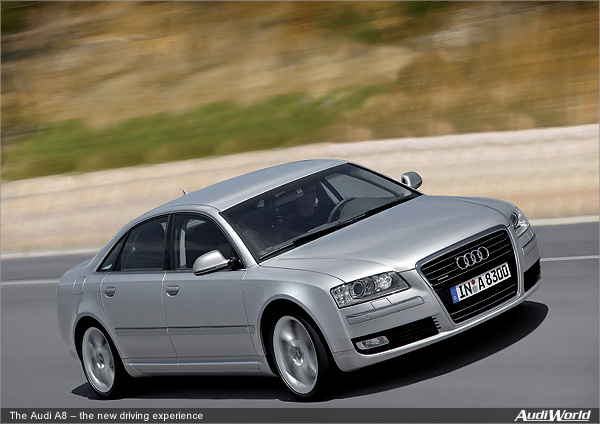The Audi A8: Assistance Systems

Support to enhance comfort and safety The Audi A8 supports the driver with state-of-the art assistance systems. They provide comfort and help to maintain fitness on long journeys thus making a vital contribution towards safety. The intelligent, radar-based adaptive cruise control, for instance, automatically controls the speed in relation to the preset distance from the vehicle in front. This noticeably reduces the driver’s workload particularly during long journeys on country roads or when driving on the motorway, especially in heavy nose-to-tail traffic. The new Audi side assist in the A8 also employs intelligent radar technology. The system was specifically designed to support lane-changing manoeuvres and it alerts the driver to hazardous situations. Two radar sensors in the rear bumper, which operate on the 24-gigahertz frequency, monitor the space next to and behind the Audi A8, up to a distance of 50 metres, to draw the drivers attention to any approaching vehicles. A high-performance computer evaluates and interprets the raw data. Hazard warning for the driver If another vehicle approaches fast from behind or is moving in the critical area at about the same speed, yellow LEDs in the housing of the left or right exterior mirror comes on permanently. So as not to cause any distraction, the display is designed to be “unobtrusive”: the driver sees it only when looking directly in the mirror; as long as he/she looks ahead, it is not noticeable. If, despite this illuminated warning signal, the A8 driver sets the indicator to change lanes, the LEDs become brighter and flash rapidly for about a second. The flash is almost impossible to overlook as the human eye is extremely sensitive to changes in contrast in the peripheral field of vision. Audi has analysed eye response and the effects of the display in every detail in extensive series of tests with drivers of various builds and ages. In addition, the optics on the inside of the mirror housing are directed in such an elaborate way that the display can be seen by the driver. For licensing reasons, it must not be visible to vehicles following behind. The brightness of the display automatically adapts to the ambient light: it adjusts to a moonless night equally as well as to bright midday sunshine; it can also be controlled via the MMI operating system. The system can be activated from a speed of 60 km/h. Camera monitors traffic lanes Yet another high-tech assistance system is now available in the Audi A8 Audi lane assist. This system alerts the driver, from a speed of 65 km/h, if he or she inadvertently moves out of the lane. A small camera, positioned above the rear-view mirror on the windscreen, monitors the road in front of the vehicle; its optical system is designed for a range of 60 m and an aperture angle of about 40 degrees. A high-performance computer, accommodated in the same housing, detects the lane markings and places the vehicle in relation to those markings. If the driver moves on to one of these lines without indicating, Audi lane assist warns him/her by causing the steering wheel to vibrate; the intensity of this can be set at three different stages via the MMI. The point at which the warning is issued can also be adjusted to one of three levels. The impulse can be triggered even before the wheel touches the line, only when crossing the line or even according to the systems own flexible assessment this adaptive mode takes the particular road conditions into account. Audi lane assist can be deactivated. A display in the instrument panel indicates when it is activated but not able to issue a warning because the lane markings cannot be detected, for instance, or because the road speed is too low. With Audi parking system advanced, even narrow multi-storey car parks are easy to negotiate. This parking assistant helps not only by issuing an acoustic signal for distances at the front and rear. In addition, a small camera, discreetly integrated in the handle of the luggage compartment lid, delivers clear and bright wide-angle images of the area behind the vehicle. They are displayed on the MMI screen; projection and reference lines provide support when reversing into a parking space. Integrated driving dynamics package As an integrated driving dynamics – assistance system, the ESP in the Audi A8 comprises the anti-lock brake system, hydraulic brake assist, electronic differential lock, traction control and of course yawing moment control the actual ESP. The ESP uses this to reduce the vehicles tendency to skid when close to the handling limits. Statistics have long established the high effectiveness of electronic stabilisation in preventing accidents and mitigating the consequences of accidents. In particular situations, however, the assistance functions can be switched off in two stages. At the first stage, only traction control is deactivated. This allows wheelspin, which may be advantageous, for instance, when driving with snow chains. The second stage, the complete deactivation of ESP, can be used by the expert driver if he/she wishes to use the full dynamic potential of the Audi A8 on a suitable stretch of road. The equipment, data and prices stated here refer to the model range offered for sale in Germany. We reserve the right to make changes. Errors and omissions excepted. |
